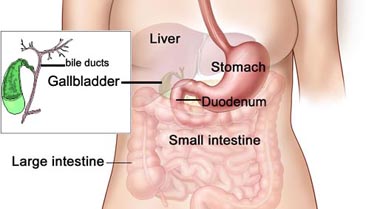Gallbladder Surgery in India
What is Gallbladder Surgery ?
In vertebrates the gallbladder (also gall bladder, biliary vesicle or cholecyst), is a small organ where bile (a fluid produced by the liver) is stored and concentrated before it is released into the small intestine. Humans can live without a gallbladder. The surgical removal of the gallbladder is called a cholecystectomy.
Histology:Omit
The layers of the gallbladder wall are visible under the microscope. The gallbladder wall's innermost surface is lined by a single layer of columnar cells with an apical brush border of microvilli, very similar to intestinal absorptive cells.Underneath the epithelia is an underlying lamina propria, a muscular layer, an outer perimuscular layer and serosa. Unlike elsewhere in the intestinal tract, the gallbladder does not have a muscularis mucosae, and the muscular fibres are not arranged in distinct layers.In greater detail, the layers are:
The epithelium is the innermost layer of the gallbladder, and is of simple columnar type. Underneath the epithelium is a lamina propria; together, these two layers are known as the mucosa. A distinctive feature of the gallbladder is the presence of Rokitansky–Aschoff sinuses, deep outpouchings of the mucosa that can extend through the muscular layer.
The muscular layer, formed by smooth muscular tissue. The interspersed muscle fibres lie in longitudinal, oblique and transverse directions, and are not arranged in separate layers. The muscle fibres here contract to expel bile from the gallbladder.
The perimuscular ("around the muscle") fibrous tissue, another layer of connective tissue
The serosa is a thick layer that covers the outer surface of the gallbladder, and is continuous with the peritoneum, which lines the abdominal cavity. The serosa contains blood vessels and lymphatics.
Function
The main purpose of the gallbladder is to store bile, also called gall. The gallbladder is part of the biliary system and serves as a reservoir for bile, which is produced by the liver. The liver produces the bile and then it flows through the hepatic ducts into the gallbladder. At any one time, 30 to 60 millilitres (1.0 to 2.0 US fl oz) of bile is stored within the gallbladder.
When food containing fat enters the digestive tract, it stimulates the secretion of cholecystokinin (CCK) from I cells of the duodenum and jejunum. In response to cholecystokinin, the gallbladder rhythmically contracts and releases its contents into the common bile duct, eventually draining into the duodenum. The bile emulsifies fats in partly digested food, thereby assisting their absorption. Bile consists primarily of water and bile salts, and also acts as a means of eliminating bilirubin, a product of hemoglobin metabolism, from the body.
Gallbladder

Gallstones
Gallstones are the most common problem to affect the gallbladder. Gallstones generally form when the bile is saturated with either cholesterol or bilirubin. Only a minority of gallstones cause symptoms; most stones are passed along the biliary system. When symptoms occur, severe pain in the upper right part of the abdomen is felt. If the stone blocks the gallbladder, inflammation as cholecystitis may result. If the stone lodges in the biliary system, jaundice may occur; and if the stone blocks the pancreatic duct, then pancreatitis may occur.
Inflammation
Inflammation of the gallbladder is known as cholecystitis. Inflammation is most commonly because of obstruction of the duct with gallstones, known as cholelithiasis.
Gallbladder removal
A cholecystectomy is a procedure in which the gallbladder is removed. It may be removed because of recurrent gallstones, and is considered an elective procedure. A cholecystectomy may be an open procedure, or one conducted by laparoscopy.